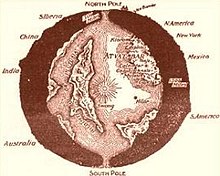In fiction[edit]
Main article: Subterranean fiction
The idea of a hollow Earth is a common element of fiction, appearing as early as Ludvig Holberg's 1741 novel Nicolai Klimii iter subterraneum (Niels Klim's Underground Travels), in which Nicolai Klim falls through a cave while spelunking and spends several years living on a smaller globe both within and the inside of the outer shell.
Other notable pre-20th century examples include Giacomo Casanova's 1788 Icosaméron, a 5-volume, 1,800-page story of a brother and sister who fall into the Earth and discover the subterranean utopia of the Mégamicres, a race of multicolored, hermaphroditic dwarves; Symzonia: A Voyage of Discovery by a "Captain Adam Seaborn" (1820) which reflected the ideas of John Cleves Symmes, Jr.; Edgar Allan Poe's 1838 novel The Narrative of Arthur Gordon Pym of Nantucket; Jules Verne's 1864 novel A Journey to the Center of the Earth, which described a prehistoric subterranean world; and George Sand's 1884 novel Laura, Voyage dans le Cristal where unseen and giant crystals could be found in the interior of the Earth.
In W.H. Hudson's 1887 romance, A Crystal Age, the protagonist falls down a hill into a Utopian, asexual, pastoral paradise; since he falls into this world, it is sometimes classified as a hollow earth story; although, the hero himself, thinks he may have traveled forward in time, by millennia.
The idea was used by Edgar Rice Burroughs, the creator of Tarzan, in the seven-novel "Pellucidar" series, beginning with At the Earth's Core (1914). Using a mechanical drill, his heroes discover a prehistoric world, called Pellucidar, 500 miles below the surface, that is lit by an inner sun.[50] The 1915 novel Plutonia by Vladimir Obruchev uses the concept of the hollow Earth to take the reader through various geological epochs.
In recent decades, the idea has become a staple of the science fiction and adventure genres, appearing in print; in film; on television programs such as Sanctuary, where Hollow Earth formed the core of the story arcs of the third and fourth seasons; in comics; in role-playing games such as the Hollow World Campaign Set for Dungeons & Dragons; in video games like Gears of War, where humans live on an Earth-like planet with a mostly hollow interior; and in many animated works.

No comments:
Post a Comment